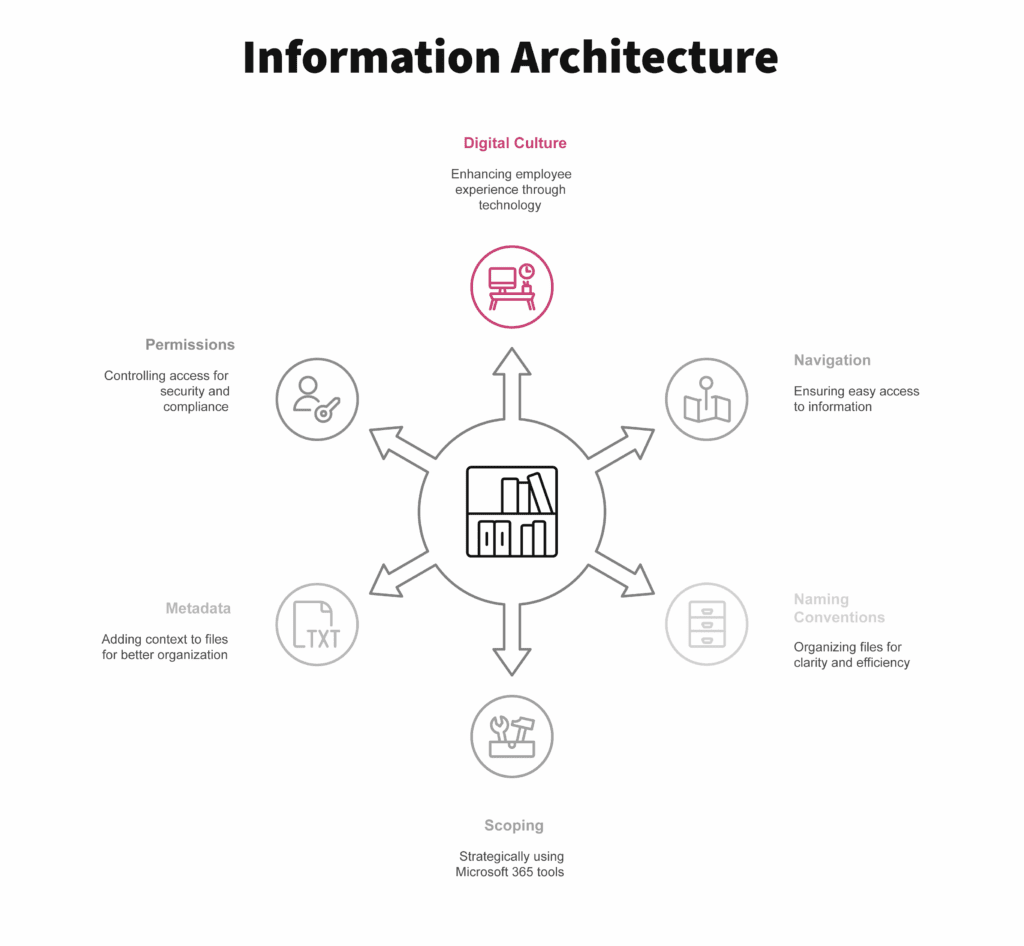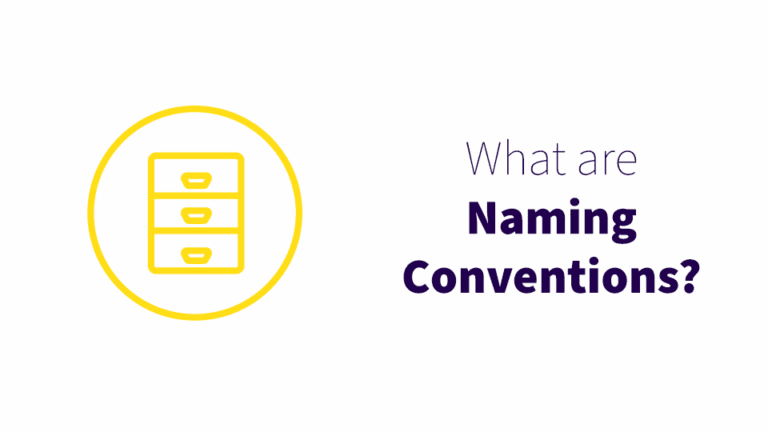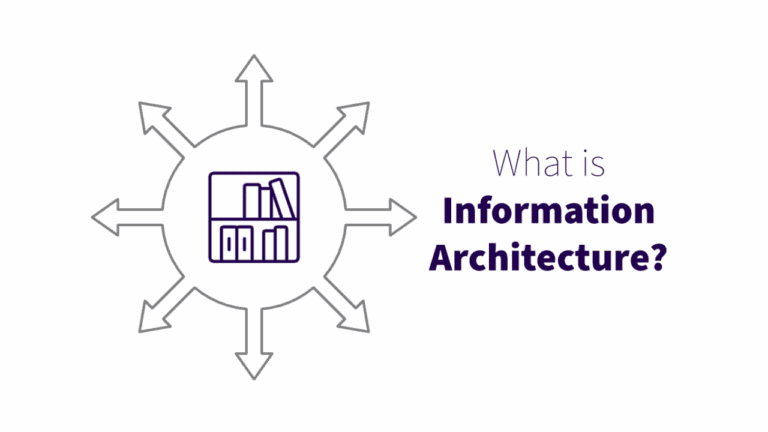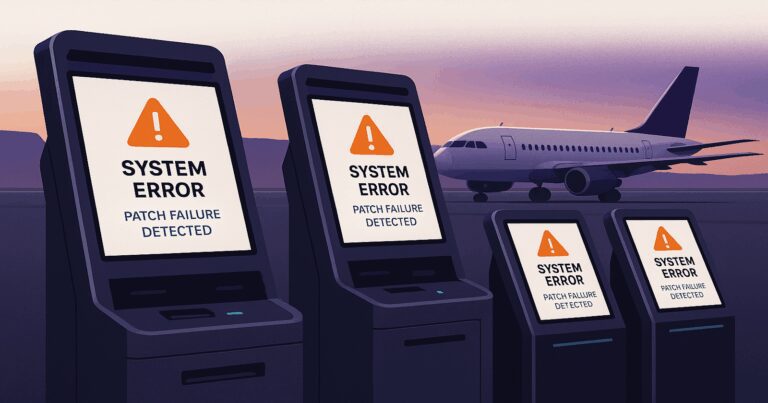Digital culture extends your company values to your technology
What is digital culture?
Tech consultancies, Microsoft marketers, or corporate thought leaders on LinkedIn – everyone seems to mean something different when they talk about digital culture. We bring up digital culture all the time when consulting with our clients, especially about information architecture. It’s such an important part of making sure your technology works for your company and employees. But what is digital culture, and why should you care?
Our definition of digital culture is:
How you represent and develop your company’s values, working style, and overall culture through the technology your employees use.
Think of it this way. If your company has (or had) physical offices, they have a certain look, feel, and function to them. Maybe you have big whiteboards to encourage brainstorming and creativity, or soundproof nooks for calls because you value privacy. Your employees show their personalities through in-jokes and the way they decorate their desks. Your digital “office” is no different. Just as having a cramped, dark office would demotivate your employees in real life, having a dull and poorly organized intranet discourages your team from using it. For remote and hybrid employees, your digital office is their office. For both productivity and company-wide satisfaction, a well-thought-out digital culture is essential.

Why is digital culture important?
Life is too short to have boring SharePoint site names. But that’s not all. Digital culture shows your employees what your company values, as well as what differentiates you from other companies. It can turn your company from a faceless entity in your employees’ eyes to a vibrant place with a real personality. It can foster teamwork and camaraderie, making your teams feel more involved and like their contributions – even their inside jokes – matter. And, crucially, a robust digital culture can convince reluctant employees to dive in and use your technology.
Goals of digital culture
Good digital culture should:
- help employees engage with information and work that would otherwise be tedious
- extend your company’s values and sense of humor into the digital workspace
- enable your remote users to feel more integrated with your on-premises users by bringing the office atmosphere into the digital space
- reinforce your corporate values
- give people a reason to go to the intranet – or at least make them hate it less
Examples of digital culture
Naming conventions to add for clarity and personality
The names of your company’s assets are key for developing digital culture. Take conference rooms, which companies often give default names like CON-376, CON-377, etc. Room names with a theme or category are easier to remember and reduce mistakes by differentiating the rooms from each other. We’ve seen companies that named their conference rooms after ski resorts (Breckenridge, Aspen, Big Sky…) or scientists (Albert Einstein, Marie Curie, Isaac Newton…).
Asset names do more than differentiate conference rooms or printers – they can bring joy and camaraderie to everyday tasks. One of our clients named their printers after Simpsons characters. It’s hard to say “Homer’s refusing to print again” or “Maggie is crying about toner” without a smile or a laugh. The printer naming convention quickly led to the team personifying the printers and making in-jokes about them. The naming conventions made printing and troubleshooting less rote and more fun.
The best naming conventions relate to your company’s industry or interests. An athletic gear company might name its intranet sites after sports stadiums, while a company with a nerdy team might choose Star Wars planets.
Naming convention best practices
Some best practices for naming company assets are:
- Get buy-in from employees. To help everyone feel a sense of ownership of your digital culture, use company-wide polling to gather ideas for naming convention themes. Get input from the C-suite to ensure the names fit the corporate interest.
- Avoid politics. Naming assets after people adds personality, but it’s wise to steer clear of politicians and other controversial figures.
- Check with HR and legal. Check that there are no potential legal or ethical issues with your naming conventions before you commit.
- Choose a category with lots of names in it. How many printers, rooms, or SharePoint sites do (and will) you have? A too-obscure theme won’t have enough names for everything.
- Keep it close, but not too close. It can be tempting to choose themes like the names of products you sell or locations in your city, but don’t do it – it’s too confusing.
Intranet strategies to drive traffic
During discovery, Wellington Street Consulting often finds that managers are struggling to get employees to use the company’s intranet. It doesn’t matter how much useful information is on the intranet – their teams are inexplicably unmotivated to go there. Luckily, it can be easier than you think to increase intranet adoption at your company.
When introducing a new intranet, a proper adoption plan can make adoption go viral. When helping with intranet introduction, WSC helps clients identify different figures at their company: innovators, early adopters, followers, and laggards. We locate influencers – like the person people go to first when they have questions – and build intranet pages they can share when helping other employees.
Other digital culture strategies we recommend for getting employees to use your intranet include:
- Be aesthetically intentional. Your intranet’s color scheme and visuals should be brand-compliant, easy to use, and differentiate subsites from each other.
- “Landmark” your pages. Default intranet pages look too similar, so differentiate them with visual landmarks like featured images. Add personality – a cute piggy bank on the finance page, or a strict professor on a policy page.
- Post information your employees care about. We’ve seen companies post their cafeteria’s daily lunch specials on the intranet. This strategy won’t directly make your team more productive, but it will get them used to going to the intranet.
- Gamify the intranet. Gamifying is just what you’d think: turning something into a game. Award your employees points through the intranet for activities that support your company’s values. Everyone will want to check the intranet to see who’s at the top of the leaderboard.
- Post an internal glossary. New employees will appreciate finding a glossary of company-specific terms on your intranet. More seasoned employees will like having a definition to link to instead of explaining themselves repeatedly.
Get the most out of your IT with digital culture
From discovery to implementation, Wellington Street Consulting can guide you through creating a digital culture that makes work easier, more satisfying, and fun for your employees and more productive and efficient for your business. Tell us your struggles – we’re here to help.







